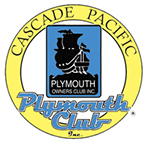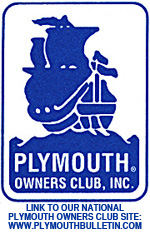Bringing a 1970 Fury Convertible back to life
By Jeff Miller
We took my Fury out for its first drive the other day, and here’s a short recap of what I’ve been up to with the car.
 The car is a 1970 Fury convertible with Sunfire Yellow paint and F8 green interior. It has the 383CI engine and an automatic transmission. I bought it just over a year ago from a guy in Vancouver, who had left it parked outside for about five years.
The car is a 1970 Fury convertible with Sunfire Yellow paint and F8 green interior. It has the 383CI engine and an automatic transmission. I bought it just over a year ago from a guy in Vancouver, who had left it parked outside for about five years.
Click here or on either of these photos to see more pictures of Jeff's project.
I had it hauled to my house and started going through it. One of the first orders of business was to remove the interior so I could check the condition of the floor. It looked really scary at first, but there were only about 10 small pinholes that were rusted all the way through.
My budget is only about $100/month and I’m not yet a welder, so replacing sections of the floor was not an option. Instead I ground off the paint and rust down to bare metal and then treated it with phosphoric acid before priming and painting. I used an aluminum-based epoxy called All-Metal to fill the pinholes.
Bob’s Paintland in Vancouver mixed up some Sunfire Yellow in rattle cans for me. The car is huge so it took quite a few cans to do the floor and trunk. My finger actually got sore from pressing the nozzle.
While the car was torn apart I repaired items in the rear of the car such as the wiring for the convertible top motor and the electric rear windows. I ran an extra wire from the front to the back for the electric fuel pump. It is currently in the engine compartment but I plan to move it close to the tank. I also did a lot of work on the interior components while they were out oft he car. This involved a lot of cleaning, treating rust, and painting. There are still holes and tears but it looks much better than it did.
 I had the front seat tracks sandblasted and then tanked to remove old grease before repainting and re greasing. They look and work great now.
I had the front seat tracks sandblasted and then tanked to remove old grease before repainting and re greasing. They look and work great now.
The biggest hurdle and disappointment involved what I thought would be the easiest part – replacing the carpet. I did a lot of research and ended up ordering a replacement from Trim Parts. The carpet itself looks great but the rear section did not fit well. Namely, the molded humps to accommodate the retractable seatbelt spools were too far forward. After a lot of back and forth with knowledgeable C- body folks and Trim Parts, we determined that Trim Parts’ mold is from a Chrysler C-body and not from a Fury. The Chrysler wheelbase is a little bit longer, and the extra distance is in the rear foot wells. Trim Parts gave me a full refund. They initially wanted me to cut the carpet up and send them a picture, but they let me keep it after I learned that the only other carpet manufacturer also used a C-body mold. Thus, I ended up “making it work” but it does not look very good. It is disappointing to cover up all my good floor work with an ill-fitting carpet. It makes it look like I didn’t do a good job.
Aside from the carpet, I am generally pleased with how it turned out after a long winter of grinding, cleaning, gluing, and painting. I was a little worried that I took it too far apart, so it was a relief to get it all back together and to finally take it for a drive. My daughter initially said she wouldn’t drive it because of the big hole in the seat, but once I fired it up she wanted to get behind the wheel and took it for a short spin.
Next up are mechanical issues. The engine seems to run well, but the car is unusually sluggish. I don’t know if it is the transmission, the engine, or both. I’ll spend this next winter working on that and maybe getting that passenger window to roll down.The steering gearbox on Plymouths (and other MoPar brands) from the late 1930s up until the mid 1950s used a worm-and-roller gear system to provide steering capability. Although they worked well, over time a few problem areas on these gearboxes can develop.


